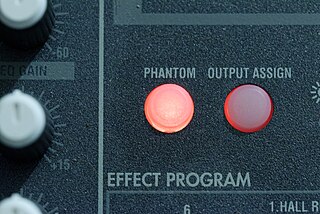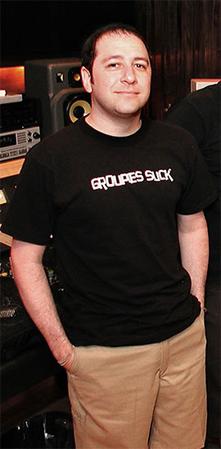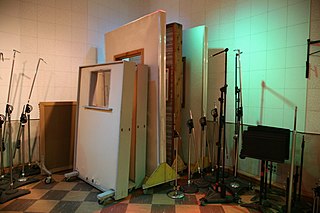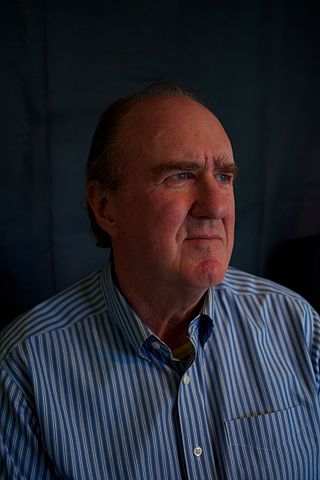
A microphone, colloquially called a mic, or mike, is a transducer that converts sound into an electrical signal. Microphones are used in many applications such as telephones, hearing aids, public address systems for concert halls and public events, motion picture production, live and recorded audio engineering, sound recording, two-way radios, megaphones, and radio and television broadcasting. They are also used in computers and other electronic devices, such as mobile phones, for recording sounds, speech recognition, VoIP, and other purposes, such as ultrasonic sensors or knock sensors.

Binaural recording is a method of recording sound that uses two microphones, arranged with the intent to create a 3D stereo sound sensation for the listener of actually being in the room with the performers or instruments. This effect is often created using a technique known as dummy head recording, wherein a mannequin head is fitted with a microphone in each ear. Binaural recording is intended for replay using headphones and will not translate properly over stereo speakers. This idea of a three-dimensional or "internal" form of sound has also translated into useful advancement of technology in many things such as stethoscopes creating "in-head" acoustics and IMAX movies being able to create a three-dimensional acoustic experience.

A recording studio is a specialized facility for recording and mixing of instrumental or vocal musical performances, spoken words, and other sounds. They range in size from a small in-home project studio large enough to record a single singer-guitarist, to a large building with space for a full orchestra of 100 or more musicians. Ideally, both the recording and monitoring spaces are specially designed by an acoustician or audio engineer to achieve optimum acoustic properties.

Johann Philipp Reis was a self-taught German scientist and inventor. In 1861, he constructed the first make-and-break telephone, today called the Reis telephone. It was the first device to transmit a voice via electronic signals and for that the first modern telephone. Reis also coined the term.

Phantom power, in the context of professional audio equipment, is DC electric power equally applied to both signal wires in balanced microphone cables, forming a phantom circuit, to operate microphones that contain active electronic circuitry. It is best known as a convenient power source for condenser microphones, though many active direct boxes also use it. The technique is also used in other applications where power supply and signal communication take place over the same wires.

A ribbon microphone, also known as a ribbon velocity microphone, is a type of microphone that uses a thin aluminum, duraluminum or nanofilm of electrically conductive ribbon placed between the poles of a magnet to produce a voltage by electromagnetic induction. Ribbon microphones are typically bidirectional, meaning that they pick up sounds equally well from either side of the microphone.

A patch cable, patch cord or patch lead is an electrical or fiber-optic cable used to connect one electronic or optical device to another for signal routing. Devices of different types are connected with patch cords.

Jermone Gregory Finn, sometimes credited as "Huckle" Jerry Finn, was an American record producer and mix engineer. He worked with numerous punk rock and pop-punk artists such as Blink-182, AFI, Sum 41, Alkaline Trio, Green Day, MxPx, and Rancid. Finn was known for the warm guitar tone present on albums he produced as well as the "punchy" sound of his mixes. He was instrumental in developing the polished sound of pop-punk in its second wave of popularity between the mid-1990s and early 2000s.

Georg Neumann GmbH is a manufacturer of professional recording microphones. It was founded by Georg Neumann and Erich Rickmann in 1928 and is based in Berlin, Germany. Its best-known products are condenser microphones for recording, broadcast, and live music production purposes. For several decades Neumann was also a leading manufacturer of cutting lathes for phonograph disks, and even ventured into the field of mixing desks. Today Neumann also manufactures preamplifiers, studio monitors, headphones, and audio interfaces.

The RCA Type 77-DX microphone is a poly-directional ribbon microphone, or pressure-gradient microphone, introduced by the RCA Corporation in 1954. It was preceded by the Type 77-D introduced in 1948. Its popularity and classic design has resulted in the 77-DX becoming an iconic microphone, used by broadcasters and media personalities such as Edward R. Murrow, David Letterman and Larry King.

An audio engineer helps to produce a recording or a live performance, balancing and adjusting sound sources using equalization, dynamics processing and audio effects, mixing, reproduction, and reinforcement of sound. Audio engineers work on the "technical aspect of recording—the placing of microphones, pre-amp knobs, the setting of levels. The physical recording of any project is done by an engineer…"

The BBC-Marconi Type A is a ribbon microphone that was produced by the BBC and Marconi between 1934 and 1959. The microphone has been described as "iconic" and a symbol of the BBC.
The lip-ribbon microphone is a type of ribbon microphone designed specially for use by live news reporters or sports commentators. Organisations such as the BBC, CBS and ABC use lip-ribbon microphones to cover events including motor racing, wrestling, processions and demonstrations.

Spill is the occurrence in sound recording and live sound mixing whereby sound is picked up by a microphone from a source other than that which is intended. Spill is usually seen as a problem, and various steps are taken to avoid it or reduce it. In some styles of music, such as orchestral music, jazz, and blues, it is more likely to be accepted or even seen as desirable.

Overhead microphones are those used in sound recording and live sound reproduction to pick up ambient sounds, transients and the overall blend of instruments. They are used in drum recording to achieve a stereo image of the full drum kit, as well as orchestral recording to create a balanced stereo recording of full orchestras.

Cliff Henricksen is a musician, inventor and audio technologist. He is self-taught as a musician with a graduate degree in mechanical engineering at Massachusetts Institute of Technology (MIT). Throughout his career Cliff has found innovative ways to apply engineering basics to electro acoustics and to audio technology as it applies to music and in particular to live music performance. He has invented and engineered a wide variety of technologies and products well known in the world of professional audio. Today he balances work in audio and work as a performing musician.
Smoke Sessions Records is an independent jazz record label based in New York City.

The Electro-Voice RE20 is an American professional cardioid dynamic microphone, commonly used in broadcasting applications since 1968. Designed by Electro-Voice using the company's patented Variable-D technology and a large-diaphragm element, it has been described as an industry standard "iconic" microphone for its natural sound and its wide usage in radio, television and recording studios. In 2015, the RE20 was inducted into the TEC Awards Technology Hall of Fame.

The Beyerdynamic M 160, sometimes referred to as Beyer M160, is a German hypercardioid ribbon microphone used for speech in broadcasting and for music in live concerts and the recording studio. Introduced in 1957 by Beyerdynamic, the M 160 was initially based on a rugged dual-ribbon transducer element with alnico magnets. The two 15-millimeter (0.59 in) ribbons combine to yield a highly directional pickup pattern. The ribbon assembly is turned 90 degrees away from the usual configuration to make the M 160 an end-address model; the similar M 130 model is a side-address microphone with a figure-8 pickup pattern. The structure later incorporated neodymium magnets as they became available.
The RCA Type 44 microphone is a bi-directional ribbon microphone, or pressure-gradient microphone, first introduced by the RCA Corporation in 1931.

















